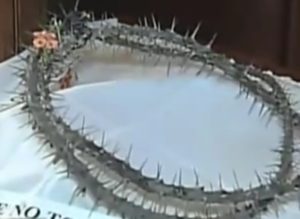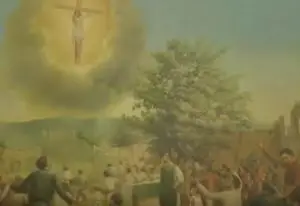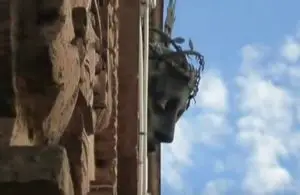Podcast: Play in new window | Download
Subscribe: Apple Podcasts | RSS
 In December of 2010 television crews from all over Latin America came to the town of Ocotlán in the Mexican state of Jalisco. Among them was Spanish-language broadcast giant Univisión which sent a film crew from their show “Primer Impacto” to cover what people throughout the region were considering to be a miracle. In the Basilica to Our Lord of Mercy something unusual was happening on the main crucifix behind the altar, the crown of thorns on the head of Jesus began to sprout flowers. The crown, which had been made out of a thorny desert plant that had been twisted into a circle, had been taken off the Jesus when Father Miguel Angel González noticed a sprout which had appeared in the back of the crown in early November of 2010. By the time of the filming of the “Primer Impacto” episode about this event, the crown of thorns had been removed from the Jesus and put under glass and monitored by security cameras. When the television crew filmed the sacred object, it had several pink, trumpet-like flowers coming out of it and a few other green shoots with leaves. Faithful from the town of Ocotlán and the surrounding areas formed a line to view the crown, and the flowers seemed extra special because it was the week before Christmas. The resident priest talked briefly about the history of this specific crown of thorns. It was given to the church as a gift in 1994 by a new bride after a wedding. The crown was placed at the foot of the cross and then moved to rest on the praying hands of a statue of the Virgin of Dolores. From the Virgin statue it was moved to its rightful place on top of the Cristo on the main crucifix in the basilica. In addition to Father Miguel Angel, the Univisión reporter also spoke with two parishioners about what they were witnessing. Gerardo Moreno stated calmly and evenly, “It’s a message
In December of 2010 television crews from all over Latin America came to the town of Ocotlán in the Mexican state of Jalisco. Among them was Spanish-language broadcast giant Univisión which sent a film crew from their show “Primer Impacto” to cover what people throughout the region were considering to be a miracle. In the Basilica to Our Lord of Mercy something unusual was happening on the main crucifix behind the altar, the crown of thorns on the head of Jesus began to sprout flowers. The crown, which had been made out of a thorny desert plant that had been twisted into a circle, had been taken off the Jesus when Father Miguel Angel González noticed a sprout which had appeared in the back of the crown in early November of 2010. By the time of the filming of the “Primer Impacto” episode about this event, the crown of thorns had been removed from the Jesus and put under glass and monitored by security cameras. When the television crew filmed the sacred object, it had several pink, trumpet-like flowers coming out of it and a few other green shoots with leaves. Faithful from the town of Ocotlán and the surrounding areas formed a line to view the crown, and the flowers seemed extra special because it was the week before Christmas. The resident priest talked briefly about the history of this specific crown of thorns. It was given to the church as a gift in 1994 by a new bride after a wedding. The crown was placed at the foot of the cross and then moved to rest on the praying hands of a statue of the Virgin of Dolores. From the Virgin statue it was moved to its rightful place on top of the Cristo on the main crucifix in the basilica. In addition to Father Miguel Angel, the Univisión reporter also spoke with two parishioners about what they were witnessing. Gerardo Moreno stated calmly and evenly, “It’s a message  because everything is pretty bad. I think that this is a sign.” Juan Manuel Nuñez, an older man with tears in his eyes trembled when he told the reporter, “I am a believer, a believer in God. It’s a warning, a warning of something.” Like most people who visited the object, the locals interviewed were not sure exactly what they were seeing, only that it was somehow supernaturally inspired and seemed to underscore their already strong religious beliefs. Father Miguel Angel assured the public that the church was going to great lengths to investigate the phenomenon and promised to keep the relic under glass with round-the-clock monitoring by security cameras to prove that the crown was not being tampered with. The “Primer Impacto” show ended by telling its viewers that the University of Guadalajara was going to make a thorough scientific investigation of the crown and would make its findings public. The intrusion of science into the realm of faith was largely ignored by the multitudes of people who came to the basilica to witness what they were claiming was the second miracle at Octotlán, the first one occurring on the same spot some 153 years before.
because everything is pretty bad. I think that this is a sign.” Juan Manuel Nuñez, an older man with tears in his eyes trembled when he told the reporter, “I am a believer, a believer in God. It’s a warning, a warning of something.” Like most people who visited the object, the locals interviewed were not sure exactly what they were seeing, only that it was somehow supernaturally inspired and seemed to underscore their already strong religious beliefs. Father Miguel Angel assured the public that the church was going to great lengths to investigate the phenomenon and promised to keep the relic under glass with round-the-clock monitoring by security cameras to prove that the crown was not being tampered with. The “Primer Impacto” show ended by telling its viewers that the University of Guadalajara was going to make a thorough scientific investigation of the crown and would make its findings public. The intrusion of science into the realm of faith was largely ignored by the multitudes of people who came to the basilica to witness what they were claiming was the second miracle at Octotlán, the first one occurring on the same spot some 153 years before.
The name “Ocotlán” comes from the language of the Aztecs, Nahuatl, and is a combination of two words, “ocotl,” or “pine tree” in English and “tlan,” which means “place of,” in English: “Place of the pine trees.” The town sits on the shores of Lake Chapala where the Zuma and Santiago rivers pour into the lake. The climate is temperate, the air is fresh and the soils are rich. A thriving indigenous settlement existed there when the Spanish first arrived in 1530 and the area had been long occupied by the Otancas, Texuexes, Tepehuanes and Coanos. One of the first major battles of conquistador Nuño de Guzmán happened at Ocotlán and when the local native kingdom was defeated, the Spanish established a permanent presence, building a hospital and a chapel dedicated to the Virgin of the Immaculate Conception under the direction of the Franciscans. The Virgin at Ocotlán quickly became known as “The Patroness of the Indians” and the building to house her became a regional pilgrimage site. Parts of that chapel still exist today and it is considered to be one of the oldest buildings in the Mexican state of Jalisco.
By the mid-1840s the town had become known as a place of vice and licentiousness, so the history goes. All of that changed abruptly on October 2, 1847. A massive earthquake hit the town leveling most buildings and causing the rest to be uninhabitable. There was much misery and death and the survivors in this town of 1,500 people were in a state of shock. In the day following the quake, the mayor of Ocotlán, Juan Antonio Ximénez wrote a letter to the governor of the state of Jalisco. The letter survives. The mayor writes:
“Yesterday, Saturday the 2nd at seven thirty in the morning a strong earthquake, which lasted more than five minutes was felt in this town. It did not, however, cause any damage. The repetition, happening between nine and ten o’clock on the same morning, was terrible. In an instant, some of the town’s buildings were knocked down, and the others were completely destroyed or in imminent danger of collapse.
As of yesterday, 46 persons of both sexes, and of various ages, had been found dead, and it is not possible now to know with certainty the number of injured and wounded who miraculously escaped the destruction.
It was not only the town that suffered this misfortune. The same thing occurred in all the other places in the municipality. There was terror and fright everywhere, especially when rocks broke away from the hill and the wild animals were terrified.”
The mayor’s last paragraph in this letter surely rose the eyebrows of the governor of Jalisco. Mayor Ximénez continues:
“This morning, Your Excellency, 24 hours after the unfortunate events, the perfect image of Our Lord Jesus Christ on the Cross was seen between west and north, formed between two clouds and lasting for half an hour, in which time more than 1,500 people who were in the plaza fell to their knees, performing acts of contrition and crying to the Lord to show mercy.”
 What the mayor described would be later called the miraculous appearance of El Señor de la Misericordia, or in English, Our Lord of Mercy. According to the survivors of the town, the day after the quake, a Sunday, everyone was gathered in the Plaza de Armas of Ocotlán, to celebrate an open-air mass because the ruined church was unfit for services. An image of Jesus appeared in the clouds sometime during the 9:00 hour. The image has been described as being everything from a fluffy cloud formation in the shape of a cross to a glimmering perfect image of a crucified Christ on whose face was an expression combining love and reassurance. The image was said to have hovered to the northwest before slowly disappearing. People in the surrounding rural areas also reported seeing the image of Jesus in the clouds. Word of this miracle spread throughout the region and Ocotlán became the focus of a new pilgrimage for people wanting to venerate what was being called the Lord of Mercy. By 1875 a new church was built to honor this manifestation of Jesus and was further expanded to the basilica complex that exists in Ocotlán to this day. With time, the event became more formalized and documented. In 1897, for the 50th anniversary of the apparition, Archbishop of Guadalajara, Pedro Loza y Pardavé, felt it necessary to take down written testimonies of the remaining 30 people who witnessed the event in 1847. By the 1890s most of Mexico had heard of the apparition and the word of the miraculous appearance was gaining international interest. Local church authorities sought to formalize and further legitimize the event and on September 29, 1911 Cardinal José de Jesús Ortiz y Rodríguez, the Archbishop of Guadalajara, signed a document acknowledging the 1897 written testimonies and proclaiming the event of 1847 as “The Miracle of Ocotlán.” In his pronouncement, the cardinal wrote:
What the mayor described would be later called the miraculous appearance of El Señor de la Misericordia, or in English, Our Lord of Mercy. According to the survivors of the town, the day after the quake, a Sunday, everyone was gathered in the Plaza de Armas of Ocotlán, to celebrate an open-air mass because the ruined church was unfit for services. An image of Jesus appeared in the clouds sometime during the 9:00 hour. The image has been described as being everything from a fluffy cloud formation in the shape of a cross to a glimmering perfect image of a crucified Christ on whose face was an expression combining love and reassurance. The image was said to have hovered to the northwest before slowly disappearing. People in the surrounding rural areas also reported seeing the image of Jesus in the clouds. Word of this miracle spread throughout the region and Ocotlán became the focus of a new pilgrimage for people wanting to venerate what was being called the Lord of Mercy. By 1875 a new church was built to honor this manifestation of Jesus and was further expanded to the basilica complex that exists in Ocotlán to this day. With time, the event became more formalized and documented. In 1897, for the 50th anniversary of the apparition, Archbishop of Guadalajara, Pedro Loza y Pardavé, felt it necessary to take down written testimonies of the remaining 30 people who witnessed the event in 1847. By the 1890s most of Mexico had heard of the apparition and the word of the miraculous appearance was gaining international interest. Local church authorities sought to formalize and further legitimize the event and on September 29, 1911 Cardinal José de Jesús Ortiz y Rodríguez, the Archbishop of Guadalajara, signed a document acknowledging the 1897 written testimonies and proclaiming the event of 1847 as “The Miracle of Ocotlán.” In his pronouncement, the cardinal wrote:
“We must acknowledge as a historical fact, perfectly proven, the apparition of the blessed image of Jesus Christ Crucified…and that it could not have been the work of an hallucination or fraud, since it happened in broad daylight, in the sight of more than 2,000 people.”
In addition, Cardinal Ortíz y Rodríguez established a formal feast day to recognize Our Lord of Mercy. In his proclamation, the cardinal continues:
“(Townsfolk) must gather together in whatever manner possible, after purifying their consciences with the holy sacraments of Penance and Holy Communion and solemnly swear in the presence of God, for themselves and their descendants, that year after year they will celebrate the October 3 anniversary.”
The following year, 1912, the formal feast to the Lord of Mercy began, which starts every September 20th and ends on the date of the apparition, October 3rd, a full 13 days of celebration, contemplation and contrition.
What does the Vatican think of this event? While not formally recognizing it as it has the appearances of the Virgin Mary – Lourdes, Guadalupe, and Fatima – it has given its tacit recognition of its miraculous nature. In 1997, on the 150th anniversary of the appearance of Jesus in the sky, Pope John Paul the Second sent an apostolic blessing to the people of Ocotlán acknowledging the importance of the event. To many Mexican Catholics, the first miracle at Ocotlán is the only legitimate appearance of Jesus as an apparition in the entire world. Pilgrims continue to visit the basilica to see the place where the event took place and recently, to see the second miracle, the flowering crown of thorns.
In the time since both the appearance of Jesus in the sky and the unexpected sprouting of the crown of thorns, many people have come forth to debunk or “re-explain” what has happened at Ocotlán. The University of Guadalajara did issue its scientific explanation for the miracle of the flowering crown in early 2011. In its comprehensive report, university scientists stated that the plant from which the crown was made – known by its scientific name, euphorbia milii – is a hardy desert plant that can go years without water. Seeds may stay dormant for decades and are activated by the slightest indications of moisture. So, after 15+ years of being “inactive,” the plant the crown was made of “came to life,” presumably because of humidity in the room or the coalescing of water droplets on the back of the head of the statue on which the crown rested. To the faithful, although the story may seem thoroughly explained and even well-intentioned, the flowering crown of thorns remains a miracle.
 The appearance of Jesus in the sky has gotten more scrutiny over the years simply because it happened so long ago and there is nothing that exists from that event like the crown of thorns that can physically be tested. On the TV show, “Extranormal,” shown on the LA-based Spanish language broadcast television network Azteca America, the hosts discussed the 1847 apparition over Ocotlán after a documentary segment presenting a timeline and describing events. The scientists – a physicist and a psychologist – came up with standard explanations of mass hallucination and tricks of light in the sky playing with the minds of a beleaguered and desperate population. The show’s resident parapsychologist, Laura Rivas, had a different explanation for the events at Ocotlán. She said that the area is the site of an energy vortex and a tonal focal point, and many paranormal events have occurred in the area and will occur in the area. Indeed, the Franciscans established the very popular Virgin of the Immaculate Conception shrine at Ocotlán in the 1530s for a reason: The location had already been known to be a somewhat holy place. Whether or not either or some parts of the miracles are true or whatever scientific explanation is put forth, pilgrims will keep making the trip to Ocotlán. The Jesus in the Sky and the flowering crown of thorns will always be in the collective Mexican memory to connect the true believers to the divine.
The appearance of Jesus in the sky has gotten more scrutiny over the years simply because it happened so long ago and there is nothing that exists from that event like the crown of thorns that can physically be tested. On the TV show, “Extranormal,” shown on the LA-based Spanish language broadcast television network Azteca America, the hosts discussed the 1847 apparition over Ocotlán after a documentary segment presenting a timeline and describing events. The scientists – a physicist and a psychologist – came up with standard explanations of mass hallucination and tricks of light in the sky playing with the minds of a beleaguered and desperate population. The show’s resident parapsychologist, Laura Rivas, had a different explanation for the events at Ocotlán. She said that the area is the site of an energy vortex and a tonal focal point, and many paranormal events have occurred in the area and will occur in the area. Indeed, the Franciscans established the very popular Virgin of the Immaculate Conception shrine at Ocotlán in the 1530s for a reason: The location had already been known to be a somewhat holy place. Whether or not either or some parts of the miracles are true or whatever scientific explanation is put forth, pilgrims will keep making the trip to Ocotlán. The Jesus in the Sky and the flowering crown of thorns will always be in the collective Mexican memory to connect the true believers to the divine.
REFERENCES:
“Primer Impacto” on Univision
“Exranormal” on Azteca America
Various online sources

5 thoughts on “Jesus in the Sky and the Flowering Crown of Thorns”
Very amazing story thank you.
Thanks for listening Peter. I appreciate your support!
An amazing story….it has received very little publicity.
You are very right about that. Ocotlan could be a major pilgrimage site if more people knew about this.
Non-believers will always find a way to discount miracles. Jesus shows himself & speaks to us in so many ways; the first miracle of Ocotlán is good enough for me!